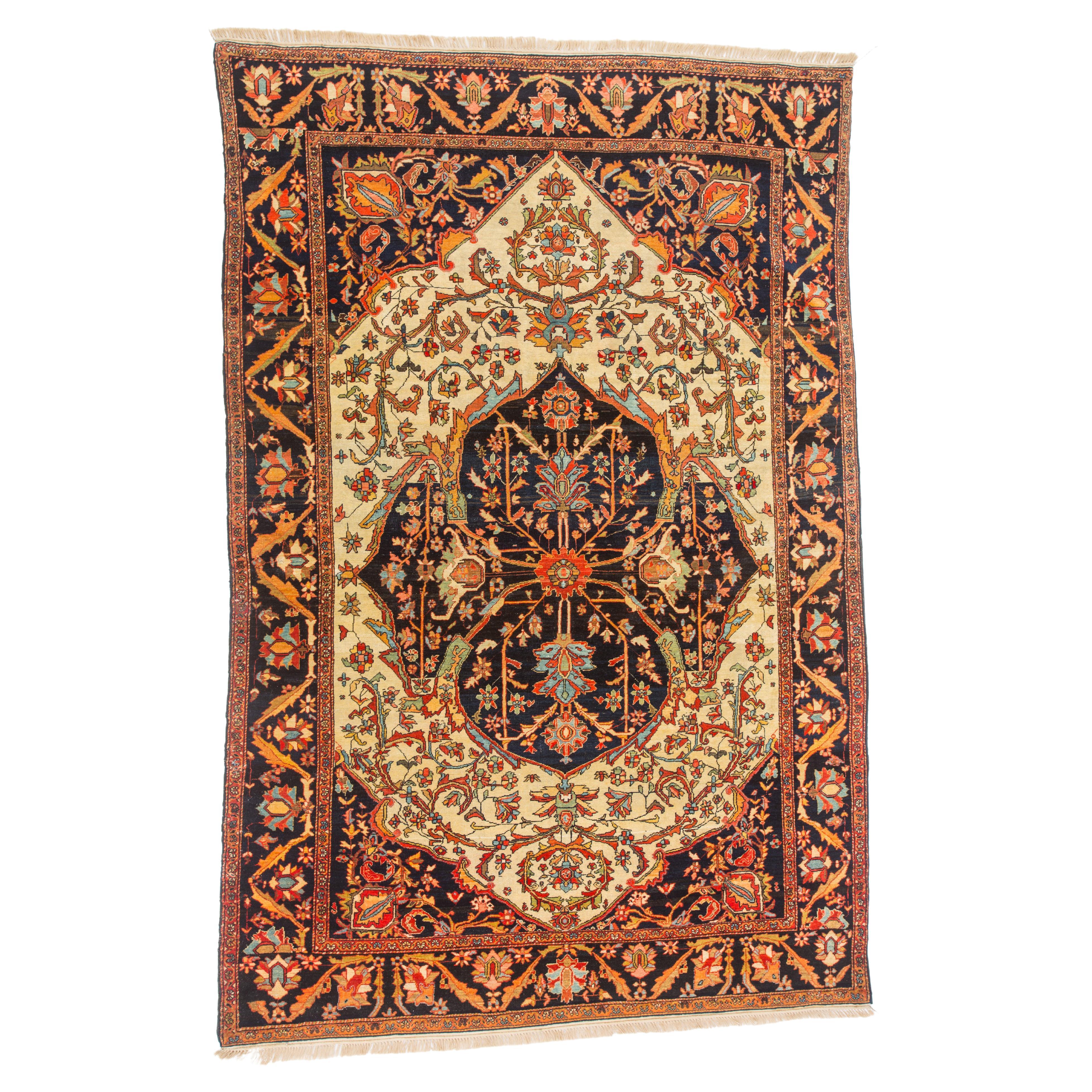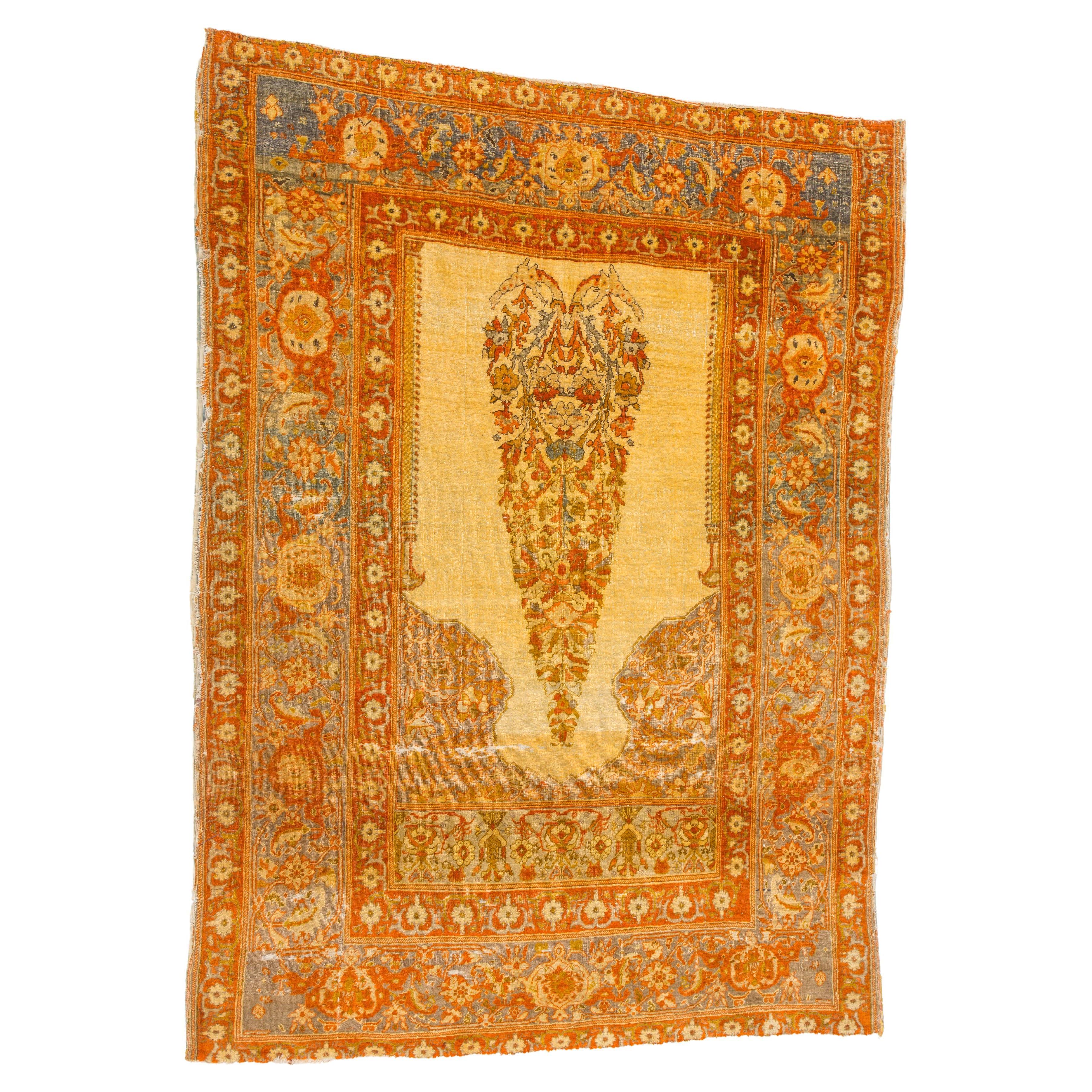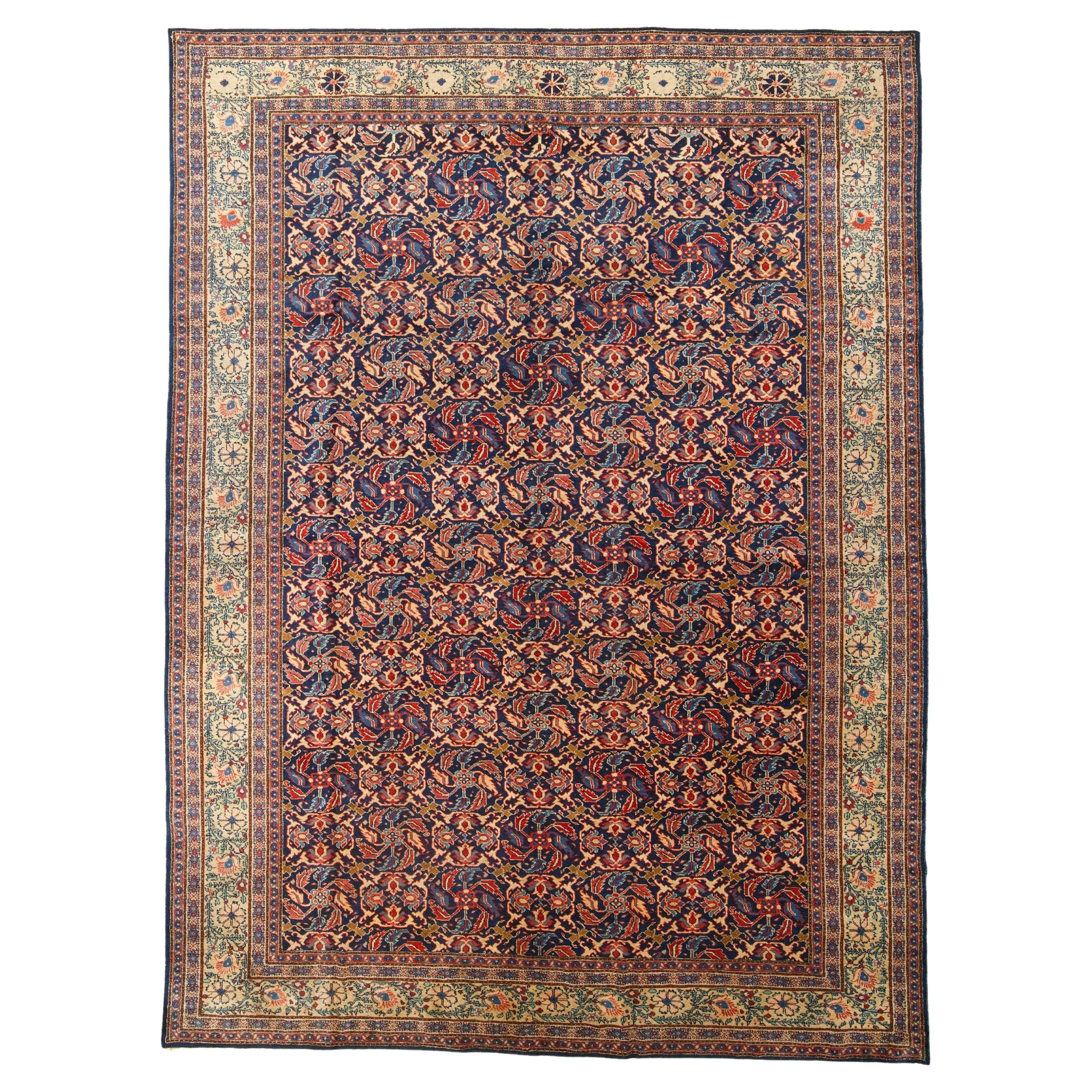Items Similar to High Collectible 19th Century Ferahan Sarouk, Princely, at Short Term Reduction
Want more images or videos?
Request additional images or videos from the seller
1 of 10
High Collectible 19th Century Ferahan Sarouk, Princely, at Short Term Reduction
About the Item
Ferahan Sarouk Museum Quality
MUSEUM QUALITY Ferahan Sarouk, third quarter 19th century
6.6 x 4.5 feet
From a USA collector
Ferahan Sarouk carpets produced around the wider Arak (formerly Sultanabad) area from about 1850-1910 earned a deserved reputation as amongst the most desirable and imaginative finely woven carpets in Persia. As these things go, they morphed in style around 1910- 1920 into the differently woven Mahajirhan Sarouk fashion (quality examples of which are also in demand) and then disappeared entirely.
Their desirability rests not only on fine weaving, and excellent wool. Many of the better examples were commissioned by aristocrats or wealthy merchants who encouraged creativity, in an actively competitive way; rugs during this period, as before, were direct illustrations of an individual’s wealth, power and prestige.
Beyond this lay a more fundamental and seemingly contradictory set of motivations by the weavers. At one and the same time they sought to emulate the great court carpets in finesse and design. And yet-- they applied rustic or village, and even tribal elements and nuances to their designs. The result was a cavalcade of creativity.
So, a village-based genre came into being which produced primarily an approx. 6x4 rug size format, and also provided, if more rarely, larger formats, which command increasingly high prices, due to their rarity, visual excitement and grandeur.
The artistic achievement of this “school” had to do with marrying elegance and a degree of formalism with whimsy, and design innovation. They offer a charm and a certain magic beyond that of court and most city carpets.
As in any area or era, there is a quality spectrum ranging from mediocre to highly superior. Superiority is judged of course as to weave and wool quality. It is rather unusual, though, to encounter pieces made before 1890 -which are bona fide Ferahan Sarouks- with poor wool or weaving: standards were upheld during this period, and natural dyes were widely employed, particularly in the wider Arak (then Sultanabad) region.
Thus, as an investment collectible to adorn the home we believe the ultimate criterion is aesthetics, this being an art form, after all.
Ferahan Sarouks have been a special area of interest for us over the decades both from artistic and investment perspectives.
Allowing for personal taste, our suggestions are few and simple. A Ferahan Sarouk ought to display a wide colour palette, fine drawing and delicate, sometimes “intense “ detail. The finest pieces also display an elevated sense of balance in the use of space.
We have seen many finely woven pieces which in our view are garish and lack one of the two key artistic elements intrinsic to the better examples of this genre – elegance. Sometimes they are overly cluttered; the drawing artistry is muddled or lost. In other cases odd and ineffective design devices are used, detracting from or interfering with an otherwise good design. The era of the Ferahan Sarouk was rife with experiments, not all of them successful.
The other important attribute, when it can be found, is original artistic creativity, even serendipity, -- or effective design innovation within the compass of this rug type and the unique standards of its prime period.
On average, we examine between 30-40 antique Ferahan Sarouks to achieve one acquisition, for the benefit of our clients.
This highly collectible more than 150-year-old carpet is an apex achievement of superior artistry and innovation. As an exemplar of its genre, it can be reasonably described as Museum quality, a term we do not often employ.
Please observe the stunning precision of the inner guard and its pinpoint sharp hooks. The elongation of the central medallion is one of its subtle but powerful innovations in form. The nod to asymmetry – which displays a refined sense of humour - is seen in the use of the small diamond figures, as one is deliberately missing from the right hand side: a wry nod to asymmetry, in an otherwise perfectly symmetrical creation.
The ultimate achievement here is in the fineness of the weaving itself, on close inspection. The herati pattern in the medallion and corners achieves an etched-on quality, a very uncommon level of attention to detail and perfectionism: clearly the work of a master. This artistic sense extends to the outer ground which is a superb example of the most subtle abrash, one of the most refined we have had the honor of viewing. The unusual beige/brown tones in the field were probably achieved by adding onion skins to the die vat. These extremely fine gradations of colour are rarely seen.(NB the colour photographs create a slightly misleading- overly yellow burnish to the field colour in spite of expert photographic efforts ) .
The deliberate choice of an ink black use of indigo provides a powerful frame (border) for this piece of art, which note in the lower right-hand corner is lifted slightly through abrash to a deep blue – to highlight the design and use of emerald green in the rosettes. The green shades lighten as the border ascends harmonizing with the tones in the central medallion.
The floating flow of flowers in the border is beautifully executed, with up to seven colours in a single figure.
No doubt a piece commissioned by an aristocrat around 1870, it is – remarkably- in virtually perfect condition. It appears to have had very minimal footwear, and great care; a piece which was proudly displayed from time to time and appreciated. Its density and strong foundation would however allow regular use within a home, and in a spacious contemporary home or office could make a wall hanging of striking impact.
This remarkable one of a kind piece is on short term reduction to coincide with our launch on 1st Dibs . Fair market value is approximately $22,000 .
Fine art as investment ? The WSJ made the following comments this year :
The vigor of the art market may seem counterintuitive, but it makes sense in the current environment,” economist Tyler Cowen recently wrote in The Washington Post. “First, many of the wealthy have been buying additional homes and wish to furnish them with art. Second, the recent run-up in inflation rates around the world has intensified the search for hedges.”
While the aforementioned artworks fall into traditional categories, some less-prominent forms of fine art also represent ideal investment opportunities, especially because they offer more attractive—i.e., significantly less costly—entry points for new collectors. Take high-collectible and connoisseur-caliber antique Oriental rugs, for example. The best 19th-century examples often sell privately between five figures and low six figures.
Today, that obscurity is fading. According to Ben Evans, the editor of Hali Magazine—a publication dedicated to the international rug and textile market—there are two primary factors to explain why antique rugs are beginning to enjoy their moment in the spotlight. “Cultural curiosity and collecting eclecticism have boosted the marketplace,” he says. “There has been an increase of interesting carpets and textiles within the broader art market, and we are finding that buyers and collectors are much more interested in owning a few high-quality carpets and rugs, which they’re buying with a connoisseur’s eye. It’s a shift from a period about 25 years ago when rugs were seen as simply a means to furnish a room.”
- Dimensions:Width: 54 in (137.16 cm)Length: 68 in (172.72 cm)
- Materials and Techniques:Wool,Woven
- Place of Origin:
- Period:
- Date of Manufacture:1880
- Condition:This rug has been so well looked after -unsurprising for the masterpiece that it is -- that it is in a virtually unused and pristine condition .
- Seller Location:WYNNUM, AU
- Reference Number:
About the Seller
No Reviews Yet
Vetted Seller
These experienced sellers undergo a comprehensive evaluation by our team of in-house experts.
1stDibs seller since 2022
- ShippingRetrieving quote...Ships From: WYNNUM, Australia
- Return PolicyA return for this item may be initiated within 3 days of delivery.
More From This SellerView All
- Aristocratic Ferahan Sarouk 1890 Antique Short Term ReductionLocated in WYNNUM, QLDARISTOCRATIC Ferahan Sarouk 1890 Measures: 6 ft 8 inches x 4 foot 4 inches Ladies, if you seek a gift for your much loved man, to make him feel like...Category
Antique 1890s Persian Persian Rugs
MaterialsWool
- Late 3rd Quarter 19th Century Antique Ferahan Sarouk, Glorious FlowersLocated in WYNNUM, QLDFerahan Sarouk, 1870 :GLORIOUS FLOWERS . From a German collector Ferahan Sarouk carpets produced around the wider Arak (formerly Sultanabad) are...Category
Antique 1870s Persian Persian Rugs
MaterialsWool
- Hard to Find Rich oversize TABRIZ PRAYER RUG ANTIQUE , SHORT TERM REDUCTIONLocated in WYNNUM, QLDTabriz Prayer Rug circa 1900 4.1 feet x 5.8 Acquired from an Istanbul dealer A strange mystery exists. Why are the vast majority of prayer rug...Category
Antique Early 19th Century Persian Persian Rugs
MaterialsWool
- Impeccable Artistic Antique Ferahan Sarouk, 1880Located in WYNNUM, QLDAcquired from a Swedish collector Ferahan Sarouk carpets produced around the wider Arak (city) area from about 1850-1900 earned a deserved reputation as amongst the most desirable and imaginative finely woven carpets in Persia. As these things go, they morphed in style around 1910- 1920 into the differently woven Mahajirhan Sarouk fashion (quality examples of which are also in demand) and then disappeared entirely. Their desirability rests not only on fine weaving, and excellent wool. Many of the better examples were commissioned by aristocrats or wealthy merchants who encouraged new approaches and creativity, one source of their excellence. Beyond this lay a more fundamental and seemingly contradictory set of motivations by the weavers. At one and the same time they sought to emulate the great court carpets in finesse and design, and yet-- they applied rustic or village, and even tribal elements and nuances to their designs. The result was a cavalcade of creativity. So, a village-based genre came into being which produced primarily an approx. 6x4 rug size format, and also provided, if more rarely, larger formats, which command increasingly high prices, due to their rarity, visual excitement and grandeur. The artistic achievement of this “school” had to do with marrying elegance and a degree of formalism with whimsy, and design innovation. They offer a charm and a certain magic beyond that of court and most city carpets. As in any area or era, there is a quality spectrum ranging from mediocre to highly superior. Superiority is judged of course as to weave and wool quality. It is rather unusual, though, to encounter pieces made before 1890 -which are bona fide Ferahan Sarouks- with poor wool or weaving: standards were upheld during this period, and natural dyes employed universally. Thus, as an investment collectible to adorn the home we believe the ultimate criterion is aesthetics, this being an art form, after all. Ferahan Sarouks have been a special area of interest for us over the decades both from artistic and investment perspectives. Allowing for personal taste, our suggestions are few and simple. A Ferahan Sarouk ought to display a wide colour palette, fine and creative drawing and delicate, sometimes “intense “detail. The finest pieces also display balance in the use of space. We have seen many finely woven pieces which in our view are garish and lack one of the two key artistic elements intrinsic to the better examples of this genre – elegance. Sometimes they are overly cluttered; the drawing artistry is muddled or lost. In other cases odd and ineffective design devices are used, detracting from or interfering with an otherwise good design. The era of the Ferahan Sarouk was rife with experiment, not all of them successful. The other important attribute, when it can be found, is original artistic creativity, even serendipity, -- or effective design innovation within the compass of this rug type and the unique standards of its prime period. On average, we examine between 20-30 antique Ferahan Sarouks...Category
Antique Late 19th Century Persian Persian Rugs
MaterialsWool
- Classic Antique 1870 Ferahan Sarouk -Intense Design VirtuesLocated in WYNNUM, QLDFrom an Australian Collector Ferahan Sarouk carpets produced around the wider Arak (formerly Sultanabad) area from about 1850-1910 earned a deserved re...Category
Antique 1870s Persian Persian Rugs
MaterialsWool
- Ersari Turkomen Very Rare small main carpet circa 1860 short term reductionLocated in WYNNUM, QLDAcquired from a Viennese collector’s estate The Ersari tribe of the wider Turkomen nation living in Turkmenistan, Afghanistan and Iran are one of the weaving tribes better known and understood by scholars. The Tekke Turkomen’s woven materials are perhaps best known in the West, followed by the Yomud, Salor and Ersaris. A Salor main carpet, 30% larger and about 40 years older than this piece recently sold in Austria for over $50,000, such is the scholarly , collection, and investment zeal found around the world . We are making this piece available at a short term steep discount to conincide with out launch on 1st Dibs . These and other kindred tribes produce rugs, bags, Amalysks (bridal bags) and Engsis (Tent doors...Category
Antique 1860s Turkestan Central Asian Rugs
MaterialsWool
You May Also Like
- Oversized Antique Persian Ferahan Sarouk Coral and Blue Rug, late 19th CenturyLocated in Hudson, NYA late 19th Century Ferahan Sarouk a with coral field color and beautiful shades pinks, greens and indigo and navy blue. Delicate floral motifs with meandering vines. A very finely w...Category
Antique 1890s Persian Persian Rugs
MaterialsWool
- Persian Sarouk Ferahan RugLocated in New York, NYAn authentic early 20th century Sarouk Ferahan carpet with classic medallion and border design. Investment-level Ferahan rugs were not produced after the 1910s, and the finer 19th and turn-of-the 20th century examples have become quite rare. The best antique Ferahan rugs...Category
Early 20th Century Persian Sarouk Farahan Persian Rugs
MaterialsWool
- Antique Ferahan Rug - Late 19th Century Ferahan Carpet in Good ConditionLocated in Sultanahmet, 34Antique Ferahan Carpet - Late 19th Century Ferahan Carpet in Good Condition 260 x 344cm (8,53 x 11,28 ft) Ferahan carpets are usually made with the asymmetrical knot on a cotton fou...Category
Antique 19th Century Azerbaijani Persian Rugs
MaterialsWool
- Antique Persian Ferahan Rug - Late 19th Century Ferahan Rug, Persian RugLocated in Sultanahmet, 34Antique Ferahan Rug Late 19th Century Ferahan Rug in Perfect Condition Size 135 x 200 cm (53,1x78,7 In) This elegant late 19th century antique Ferahan carpet will increase the elega...Category
Antique Late 19th Century Asian Persian Rugs
MaterialsWool
- Antique Persian Sarouk Ferahan RugLocated in New York, NYA turn of the 20th century Persian Sarouk Ferehan rug. The finely woven antique Sarouck Ferahan carpets of the 19th century were designed for the Persian aristocracy, who valued t...Category
Early 20th Century Persian Dutch Colonial Persian Rugs
MaterialsWool
- Antique Persian Sarouk Ferahan RugLocated in New York, NYA turn of the 20th century Persian Sarouk Ferehan rug. Measures: 10'7'' x 13'4'' The finely woven antique Sarouck Ferahan carpets of the 19th century were designed for the Pers...Category
Early 20th Century Persian Dutch Colonial Persian Rugs
MaterialsWool
Recently Viewed
View AllMore Ways To Browse
Short Set
Persian Framed Art
Odd Antique
Antique Hook And Eye
Large Format Wall Art
Antique Level Collectors
Onion Pattern
Antique Museum Display Cases
Antique Museum Display Case
Good Taste In Fashion
Large Wall Textiles Blue
Hanging Display Case
Wall Framed Rug
Large Antique Wall Textile
Antique Framed Figure Drawing
Oriental Hanging
Antique Whimsy
Antique Flow Blue Flow Blue





